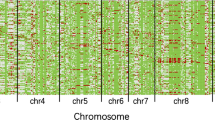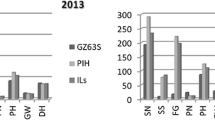Abstract
Although heterosis is widely exploited in agriculture, a clear understanding of its genetic bases is still elusive. This work describes the development of maize recombinant near-isogenic lines (NILs) for the mendelization of six heterotic QTL previously identified based on a maize (Zea mays L.) RIL population. The efficient and inexpensive strategy adopted to generate sets of NILs starting from QTL-specific residual heterozygous lines (RHLs) is described and validated. In particular, we produced nine pairs of recombinant NILs for all six QTL starting from RHLs F4:5 originally obtained during the production of the RIL population mentioned above. Whenever possible, two different NIL pairs were generated for each QTL. The efficiency of this procedure was tested by analyzing two segregating populations for two of the selected heterotic QTL for plant height, yield per plant and ears per plant. Both additive and dominant effects were observed, consistently with the presence of the QTL within the introgressed regions. Refinement of QTL detection was consistent with previous observations in terms of effects and position of the considered QTL. The genetic material developed in this work represents the starting point for QTL fine mapping aimed at understanding the genetic bases of hybrid vigor in maize.



Similar content being viewed by others
References
Allard RW (1960) Principles of plant breeding. Wiley, New York
Barth S, Busimi AK, Friedrich Utz H, Melchinger AE (2003) Heterosis for biomass yield and related traits in five hybrids of Arabidopsis thaliana L. Heynh. Heredity 91:36–42
Bruce AB (1910) The Mendelian theory of heredity and the argumentation of vigor. Science 32:627–628
Cheng S-H, Zhuang J-Y, Fan Y-Y, Du J-H, Cao L-Y (2007) Progress in research and development on hybrid rice: a super-domesticate in China. Ann Bot 100:959–966
Crow JF (1948) Alternative hypotheses of hybrid vigor. Genetics 33:477–487
Crow JF (2000) The rise and fall of overdominance. Plant Breed Rev 17:225–257
East EM (1936) Heterosis. Genetics 21:375–397
Edwards MD, Helentjaris T, Wright S, Stuber CW (1992) Molecular-marker-facilitated investigations of quantitative trait loci in maize. TAG Theor Appl Genet 83:765–774
Eshed Y, Zamir D (1995) An introgression line population of Lycopersicon pennellii in the cultivated tomato enables the identification and fine mapping of yield-associated QTL. Genetics 141:1147–1162
Falconer DS (1989) Introduction to quantitative genetics. Longman Scientific & Technical, London
Fehr WR (1987) Principles of cultivar development. MacMillan, New York
Frascaroli E, Canè MA, Landi P, Pea G, Gianfranceschi L, Villa M, Morgante M, Pè ME (2007) Classical genetic and quantitative trait loci analyses of heterosis in a maize hybrid between two elite inbred lines. Genetics 176:625–644
Fridman E, Carrari F, Liu YS, Fernie AR, Zamir D (2004) Zooming in on a quantitative trait for tomato yield using interspecific introgressions. Science 305:1786–1789
Frova C, Krajewski P, di Fonzo N, Villa M, Sari-Gorla M (1999) Genetic analysis of drought tolerance in maize by molecular markers. I. Yield components. TAG Theoret Appl Genet 99:280–288
Graham GI, Wolff DW, Stuber CW (1997) Characterization of a yield quantitative trait locus on chromosome five of maize by fine mapping. Crop Sci 37:1601–1610
Haley SD, Afanador LK, Miklas PN, Stavely JR, Kelly JD (1994) Heterogeneous inbred populations are useful as sources of near-isogenic lines for RAPD marker localization. TAG Theoret Appl Genet 88:337–342
Hochholdinger F, Hoecker N (2007) Towards the molecular basis of heterosis. Trends Plant Sci 12:427–432
Hua J, Xing Y, Wu W, Xu C, Sun X, Yu S, Zhang Q (2003) Single-locus heterotic effects and dominance by dominance interactions can adequately explain the genetic basis of heterosis in an elite rice hybrid. Proc Natl Acad Sci USA 100:2574–2579
Jones DF (1917) Dominance of linked factors as a means of accounting for heterosis. Genetics 2:466–479
Kaeppler SM, Phillips RL, Kim TS (1993) Use of near-isogenic lines derived by backcrossing or selfing to map qualitative traits. TAG Theoret Appl Genet 87:233–237
Kearsey MJ, Farquhar AG (1998) QTL analysis in plants; where are we now? Heredity 80:137–142
Kusterer B, Piepho HP, Utz HF, Schon CC, Muminovic J, Meyer RC, Altmann T, Melchinger AE (2007) Heterosis for biomass-related traits in Arabidopsis investigated by quantitative trait loci analysis of the triple testcross design with recombinant inbred lines. Genetics 177:1839–1850
Li Z-K, Luo LJ, Mei HW, Wang DL, Shu QY, Tabien R, Zhong DB, Ying CS, Stansel JW, Khush GS, Paterson AH (2001) Overdominant epistatic loci are the primary genetic basis of inbreeding depression and heterosis in Rice. I. Biomass and grain yield. Genetics 158:1737–1753
Lippman ZB, Zamir D (2007) Heterosis: revisiting the magic. Trends Genet 23:60–66
Lu H, Romero-Severson J, Bernardo R (2003) Genetic basis of heterosis explored by simple sequence repeat markers in a random-mated maize population. TAG Theoret Appl Genet 107:494–502
Luo LJ, Li ZK, Mei HW, Shu QY, Tabien R, Zhong DB (2001) Overdominant epistatic loci are the primary genetic basis of inbreeding depression and heterosis in rice. II. Grain yield components. Genetics 158:1755–1771
Manichaikul A, Dupuis J, Sen S, Broman KW (2006) Poor performance of bootstrap confidence intervals for the location of a quantitative trait locus. Genetics 174:481–489
Melchinger AE (1999) Genetic diversity and heterosis. In: Coors JG, Pandey S (eds) The genetics and exploitation of heterosis in crops. ASA, CSSA and SSA, Madison, pp 99–118
Melchinger AE, Messmer MM, Lee M, Woodman WL, Lamkey KL (1991) Diversity and relationships among U.S. maize inbreds revealed by restriction-fragment-length-polymorphisms. Crop Sci 31:669–678
Melchinger AE, Piepho HP, Utz HF, Muminovic J, Wegenast T, Torjek O, Altmann T, Kusterer B (2007) Genetic basis of heterosis for growth-related traits in Arabidopsis investigated by testcross progenies of near-isogenic lines reveals a significant role of epistasis. Genetics 177:1827–1837
Meyer RC, Torjek O, Becher M, Altmann T (2004) Heterosis of biomass production in Arabidopsis. Establishment during early development. Plant Physiol 134:1813–1823
Paterson AH (1995) Molecular dissection of quantitative traits: progress and prospects. Genome Res 5:321–333
Paterson AH, DeVerna JW, Lanini B, Tanksley SD (1990) Fine mapping of quantitative trait loci using selected overlapping recombinant chromosomes, in an interspecies cross of tomato. Genetics 124:735–742
Sari-Gorla M, Krajewski P, Binelli G, Frova C, Taramino G, Villa M (1997) Genetic dissection of herbicide tolerance in maize by molecular markers. Mol Breed 3:481–493
Institute SAS (1996) SAS Users Guide: statistic. SAS Institute Inc, Cary
Semel Y, Nissenbaum J, Menda N, Zinder M, Krieger U, Issman N, Pleban T, Lippman Z, Gur A, Zamir D (2006) Overdominant quantitative trait loci for yield and fitness in tomato. Proc Natl Acad Sci USA 103:12981–12986
Shull GH (1908) The composition of a field of maize. Rep Am Breed Assoc 4:296–301
Stuber CW, Lincoln SE, Wolff DW, Helentjaris T, Lander ES (1992) Identification of genetic factors contributing to heterosis in a hybrid from two elite maize inbred lines using molecular markers. Genetics 132:823–839
Syed NH, Chen ZJ (2005) Molecular marker genotypes, heterozygosity and genetic interactions explain heterosis in Arabidopsis thaliana. Heredity 94:295–304
Tanksley SD (1993) Mapping polygenes. Annu Rev Genet 27:205–233
Tian F, Li DJ, Fu Q, Zhu ZF, Fu YC, Wang XK, Sun CQ (2006) Construction of introgression lines carrying wild rice (Oryza rufipogon Griff.) segments in cultivated rice (Oryza sativa L.) background and characterization of introgressed segments associated with yield-related traits. TAG Theor Appl Genet 112:570–580
Tong JP, Liu XJ, Zhang SY, Li SQ, Peng XJ, Yang J, Zhu YG (2007) Identification, genetic characterization, GA response and molecular mapping of Sdt97: a dominant mutant gene conferring semi-dwarfism in rice (Oryza sativa L.). Genet Res 89:221–230
Tuinstra MR, Ejeta G, Goldsbrough PB (1997) Heterogeneous inbred family (HIF) analysis: a method for developing near-isogenic lines that differ at quantitative trait loci. TAG Theor Appl Genet 95:1005–1011
Xiao J, Li J, Yuan L, Tanksley SD (1995) Dominance is the major genetic basis of heterosis in rice as revealed by QTL analysis using molecular markers. Genetics 140:745–754
Yamanaka N, Watanabe S, Toda K, Hayashi M, Fuchigami H, Takahashi R, Harada K (2005) Fine mapping of the FT1 locus for soybean flowering time using a residual heterozygous line derived from a recombinant inbred line. TAG Theor Appl Genet 110:634–639
Yu SB, Li JX, Xu CG, Tan YF, Gao YJ, Li XH, Zhang Q, Maroof MA (1997) Importance of epistasis as the genetic basis of heterosis in an elite rice hybrid. Proc Natl Acad Sci USA 94:9226–9231
Acknowledgments
This work was supported by the Italian Ministry of University and Research (MIUR), the Programmi di Ricerca Scientifica di Rilevante Interesse Nazionale (PRIN) projects entitled “A Molecular and Quantitative Analysis of Heterosis in Maize’’ (2003) and “Sequence variability and heterosis in crop species” (2005).
Author information
Authors and Affiliations
Corresponding author
Additional information
Communicated by M. Yano.
Electronic supplementary material
Below is the link to the electronic supplementary material.
438_2008_422_MOESM1_ESM.pdf
Figure S1. Linkage map used for refinement of QTL detection. Cumulative distances are reported in cM (Kosambi mapping function) (PDF 16 kb)
Rights and permissions
About this article
Cite this article
Pea, G., Paulstephenraj, P., Canè, M.A. et al. Recombinant near-isogenic lines: a resource for the mendelization of heterotic QTL in maize. Mol Genet Genomics 281, 447–457 (2009). https://doi.org/10.1007/s00438-008-0422-6
Received:
Accepted:
Published:
Issue Date:
DOI: https://doi.org/10.1007/s00438-008-0422-6




